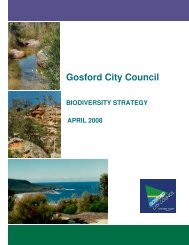Cockrone Lagoon Aquatic Biological Survey-Final Report (PDF File ...
Cockrone Lagoon Aquatic Biological Survey-Final Report (PDF File ...
Cockrone Lagoon Aquatic Biological Survey-Final Report (PDF File ...
You also want an ePaper? Increase the reach of your titles
YUMPU automatically turns print PDFs into web optimized ePapers that Google loves.
Australian <strong>Aquatic</strong> <strong>Biological</strong> Pty Ltd<br />
<strong>Report</strong> Summary<br />
<strong>Biological</strong> surveys were undertaken as part of both the broad Australian Craysh Project (ACP)<br />
& Australian <strong>Aquatic</strong> <strong>Biological</strong> <strong>Survey</strong> (AABS) and a targeted sub-project on Gosford LGA<br />
(Project #100056, Australian <strong>Aquatic</strong> <strong>Biological</strong> 2010). The main sponsors for this project were<br />
Australian <strong>Aquatic</strong> <strong>Biological</strong> and Gosford City Council under their Ecological Research Grants<br />
Program 2010 that was assisting with biological research projects for the whole Gosford LGA.<br />
<strong>Survey</strong>s of the Gosford LGA are completed on a catchment/drainage basis and the area from<br />
Copacabana to MacMasters Beach incorporating <strong>Cockrone</strong> <strong>Lagoon</strong> is the forth catchment area<br />
surveyed completely as part of the broader Gosford LGA project.<br />
The <strong>Cockrone</strong> <strong>Lagoon</strong> catchment was surveyed in late August and September 2010 and the ndings<br />
are presented in this report. <strong>Survey</strong>s were conducted during mild spring conditions when all the<br />
ephemeral creeks and swamps had some water in them.<br />
Only low numbers of native sh species were recorded, as well as exotic Gambusia. No freshwater<br />
craysh were found in the catchment. As expected no mussels or crabs were found within the<br />
catchment. Both freshwater snails and shrimp were recorded from the catchment. Generally, the<br />
riparian zones looked good, with low exotic terrestrial weeds and without litter or major exotic<br />
aquatic weed infestations which was excellent news. Despite this aquatic biodiversity & population<br />
densities within the upper catchment were exceptionally poor.<br />
The full results of this aquatic biodiversity survey are presented in this report.<br />
Key words: <strong>Cockrone</strong> <strong>Lagoon</strong>, Gambusia, amphipod, gudgeon, parrot’s feather<br />
Figure 1. <strong>Cockrone</strong> <strong>Lagoon</strong> from Lakeside Drive<br />
<strong>Cockrone</strong> <strong>Lagoon</strong> Catchment <strong>Aquatic</strong> Biodiversity <strong>Report</strong> 3

















